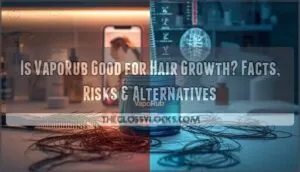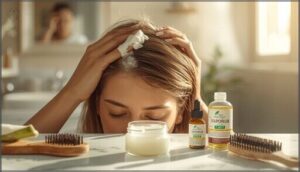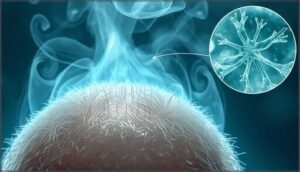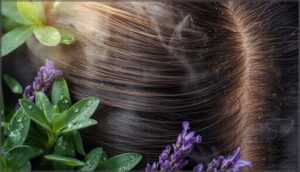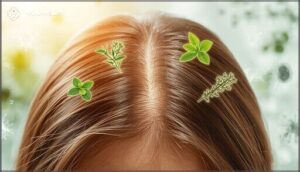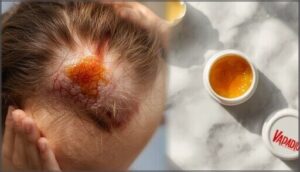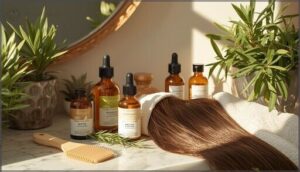This site is supported by our readers. We may earn a commission, at no cost to you, if you purchase through links.
A jar of chest rub meant for coughs somehow became the star of millions of hair growth videos online. People swear VapoRub transformed their thinning edges and bald spots, with testimonials racking up views and sparking heated debates in beauty communities. The hype started around 2016 and hasn’t died down since.
But here’s the catch: VapoRub was never designed for your scalp, and its ingredients—camphor, menthol, eucalyptus—work as counterirritants for congestion, not follicle stimulators. While some compounds in the formula show promise in limited research, there’s zero clinical evidence that slathering this medicated ointment on your head will grow new hair.
Before you raid your medicine cabinet, let’s separate the viral claims from what dermatologists actually recommend for hair loss.
Table Of Contents
- Key Takeaways
- What is VapoRub and How is It Used?
- Why Do People Use VapoRub for Hair Growth?
- Do VapoRub Ingredients Support Hair Growth?
- Is There Scientific Evidence for Hair Growth?
- What Are The Risks of Using VapoRub on Hair?
- What Are Effective Alternatives for Hair Growth?
- Frequently Asked Questions (FAQs)
- Conclusion
Key Takeaways
- VapoRub has zero clinical evidence supporting hair growth despite viral social media claims starting in 2016, and dermatologists consistently warn against using a chest rub product designed for congestion on your scalp.
- The active ingredients (camphor, menthol, eucalyptus) may theoretically improve scalp circulation and fight dandruff-causing microbes, but individual studies on these compounds don’t prove VapoRub itself grows hair.
- Real risks include scalp irritation, allergic reactions, and petroleum-based buildup that clogs follicles—making this trend potentially harmful rather than helpful for your hair health.
- FDA-approved minoxidil and natural oils like rosemary offer proven alternatives with actual research backing, while VapoRub remains an unverified home remedy that could do more harm than good.
What is VapoRub and How is It Used?
You’ve probably seen that little blue jar sitting in your medicine cabinet for years. Vicks VapoRub was created to ease cold symptoms, not to grow hair.
Let’s look at what it actually contains and how people generally use it.
Original Purpose and Common Uses
VapoRub started in 1894 as Croup Salve to help a pharmacist’s sick child, and it’s been a cultural remedy ever since. You probably know its distinctive scent legacy—that cooling menthol smell signals pain relief and comfort for cold and flu symptoms.
Today, Vicks VapoRub uses extend beyond chest rubs. With global sales exceeding a million gallons yearly, people apply Vicks Vapor Rub for muscle aches, congestion, and even coughs. Vicks VapoRub contains menthol and camphor which act as counterirritants for muscle pain. You rub it on your chest, throat, or back, where body heat releases soothing vapors that ease breathing overnight.
Key Ingredients and Their Functions
Behind that recognizable scent lie specific active ingredients that make VapoRub work. The formula combines several compounds, each serving a purpose:
- Camphor (4.7-4.8%) acts as a cough suppressant and offers antibacterial benefits that fight dandruff-causing yeast
- Menthol (2.6-2.8%) creates that cooling sensation while widening blood vessels to boost circulation
- Eucalyptus oil (1.2%) contains eucalyptol with antimicrobial effects that keep your scalp clean
Petrolatum forms the base, while inactive components like cedarleaf oil and thymol add preservative properties. As a topical cough suppressant, VapoRub provides temporary relief.
Why Do People Use VapoRub for Hair Growth?
The buzz around VapoRub for hair growth didn’t come from doctors or scientists—it started on social media. Videos and personal testimonials began spreading in 2016, with people claiming they saw real results on their thinning edges and bald spots.
Here’s what drove the trend and how people actually use it.
Social Media Trends and Testimonials
The buzz around Vicks VapoRub for hair growth exploded on TikTok and Instagram by 2024, with viral claims showing up to an inch of growth in a month. Beauty bloggers and everyday users shared millions of views worth of testimonials, especially within the African American community.
You’ll find reports of thicker edges, reduced shedding, and improved scalp health, though results generally take 30 to 60 days. While ingredient hype centers on menthol and eucalyptus, social cautions remind you there’s no scientific backing for these hair growth results.
Popular Application Methods
Most people massage a pea-sized amount directly into their hairline or thinning areas using gentle circular motions. You’ll find two main camps: some apply Vicks VapoRub straight from the jar, while others mix it with coconut or castor oil to cut the intensity.
The typical routine involves 30-minute sessions before rinsing, done 2-3 times weekly. Some leave it overnight with a shower cap, though experts warn against this due to headache risks. Hair edge application remains the most popular topical application method for this unconventional home remedy.
Do VapoRub Ingredients Support Hair Growth?
VapoRub contains several active ingredients that supporters say might help with hair growth. Each ingredient has properties that could affect your scalp and hair follicles in different ways.
Let’s look at what these compounds actually do and whether the claims hold up.
Camphor, Menthol, and Scalp Stimulation
Two key ingredients in VapoRub—camphor and menthol—work like tiny engines for your scalp. Camphor benefits include boosting blood circulation in scalp tissue, while menthol impact involves dilating blood vessels around hair follicles. Combined effects deliver better nutrient flow to roots.
Research shows menthol can increase follicle depth, though safety concerns exist for sensitive skin.
Eucalyptus and Lavender for Hair Health
Eucalyptus benefits include soothing inflamed scalps and boosting hair elasticity, while lavender effects range from reducing stress-related shedding to improving blood flow around follicles. Both oils in VapoRub offer hair health support, though their concentrations remain quite low.
- Eucalyptus oil contains cineole, which calms irritation and fights dandruff
- Lavender effects include stimulating follicles and strengthening hair growth in lab studies
- Scalp purification happens as lavender reduces oiliness and bacterial buildup
- Hair elasticity improves with eucalyptus, creating stronger, shinier strands
- Oil safety requires dilution—undiluted essential oils can irritate your skin
Antimicrobial Properties and Scalp Care
Since healthy scalp care starts with controlling microbes, VapoRub’s antimicrobial properties deserve attention. Camphor and thymol tackle fungal infections like dandruff, while eucalyptus fights drug-resistant bacteria—all promoting scalp microbial balance and inflammation reduction.
| Ingredient | Antimicrobial Action | Scalp Benefit |
|---|---|---|
| Camphor | Antibacterial, antifungal | Reduces itchy scalp |
| Thymol | Fungal infection control | Fights ringworm |
| Eucalyptus | Broad-spectrum antimicrobial | Improves follicle environment |
Anecdotal evidence suggests these effects support scalp health, though petroleum may clog follicles.
Is There Scientific Evidence for Hair Growth?
You’ve heard the hype, but what does the science actually say? As for VapoRub and hair growth, the research picture is pretty thin.
Let’s look at what clinical studies show and what dermatologists think about this trend.
Clinical Studies on VapoRub and Hair Growth
Here’s the reality: clinical studies directly testing VapoRub for hair growth simply don’t exist. No published trials have examined whether ingredients in Vicks VapoRub actually stimulate your follicles.
No clinical studies have ever tested whether VapoRub actually grows hair
However, some individual components show promise. Lavender trials in mice demonstrated hair growth comparable to minoxidil. Menthol promotion of scalp circulation appears in recent research, while eucalyptus effects on hair strength have been documented. Camphor evidence remains theoretical.
Without dedicated VapoRub studies, we’re connecting dots that haven’t been scientifically linked yet.
Dermatologist and Expert Opinions
Board-certified dermatologists remain unconvinced about VapoRub’s hair growth claims. Expert recommendations consistently point toward medical options for hair growth like minoxidil instead of chest rubs. Scientific verification simply doesn’t exist for this popular social media trend.
Clinical context matters here:
- No dermatology studies confirm VapoRub stimulates follicles
- Potential risks include scalp irritation and allergic reactions
- Public perception often confuses cosmetic improvements with actual growth
- Hair loss specialist consultation remains your safest starting point
Most specialists hadn’t even heard of this trend until patients asked about it.
What Are The Risks of Using VapoRub on Hair?
VapoRub wasn’t designed for your scalp, so using it on hair comes with real risks you need to know about. Some people experience irritation or allergic reactions, while others run into problems with the petroleum base clogging their hair.
Let’s look at three specific concerns that could affect your scalp and hair health.
Potential for Scalp Irritation or Allergic Reactions
VapoRub wasn’t designed for your scalp, and that matters. Its ingredients—camphor, menthol, turpentine oil—can trigger irritation or allergic reactions. Skin sensitivity varies widely, so what works for one person might cause redness, itching, or even contact dermatitis for you. Before applying it anywhere on your head, do a patch test. If you notice hives or scaling, stop immediately. Improper use increases these risks considerably.
| Reaction Type | Common Symptoms | Who’s at Risk |
|---|---|---|
| Mild irritation | Redness, itching | Sensitive skin types |
| Allergic dermatitis | Hives, rash, scaling | Anyone, more common in women |
| Chemical burns | Skin damage, pain | Those heating VapoRub before use |
Effects of Petroleum-Based Ingredients
Beyond irritation, petroleum jelly in VapoRub creates an occlusive barrier that locks in moisture—but also traps oils, sweat, and debris. This buildup potential clogs hair follicles, possibly worsening dandruff or folliculitis.
Washing challenges arise because petroleum resists regular shampoo, leaving greasy residue that weighs hair down.
Natural alternatives like coconut or jojoba oil moisturize without these risks, supporting scalp health more effectively.
Suitability for Different Hair and Skin Types
Not everyone reacts the same way. If you have scalp sensitivity or skin sensitivities, VapoRub’s menthol may sting or cause rashes. Oily scalps risk extra product buildup, while dry hair texture suffers when petroleum blocks moisture.
Many in the African American community with afro hair report mixed results—some see less dandruff, others experience clogged follicles.
Diluting with carrier oils helps, but patch-testing remains your safest first step.
What Are Effective Alternatives for Hair Growth?
If you’re looking for real results, skip the VapoRub and stick with what actually works. The good news is you’ve got options—both medical treatments backed by research and gentler natural approaches that support your scalp without the guesswork.
Let’s look at what dermatologists recommend when patients want healthier, fuller hair.
Proven Medical Treatments (e.g., Minoxidil)
Unlike VapoRub, minoxidil stands as the only FDA-approved topical solution for hair loss treatment. Here’s what makes it effective:
- Topical solutions (5% concentration) increase hair count by over 30% on average, with 62% of users seeing reduced hair loss areas
- Oral minoxidil produces comparable results to topical applications in clinical trials
- Treatment adherence matters—consistent twice-daily use yields best outcomes
- Regulatory approval backs its safety and minoxidil efficacy through controlled studies
Natural Oils and DIY Remedies
If minoxidil isn’t right for you, several natural oils show promise. Rosemary oil matched 2% minoxidil’s results after 6 months in human trials. Peppermint oil boosted growth by 92% in research studies. Here’s how DIY hair growth products compare:
| Natural Oil | Key Benefit |
|---|---|
| Rosemary oil | Increases follicle counts |
| Coconut oil | Reduces breakage by 39% |
| Jojoba oil | Enhances scalp blood flow |
Essential oils need proper dilution. Scalp massage with carrier oils improves thickness, but home remedies for hair growth can irritate sensitive skin. Mix 2-3 drops of essential oil per tablespoon of carrier oil. Patch test first—13-22% of users experience reactions to concentrated herbal infusions.
Remember remedy limitations. DIY hair care lacks consistent results across all hair types. Onion juice causes irritation in 17% of undiluted applications. While 61% of people try oil-based treatments, studies show average improvement rates below 50%. Combine these approaches with proven methods for best outcomes.
Tips for Safe and Healthy Hair Growth
Instead of chasing quick fixes, focus on what science confirms works. Keep your scalp pH balanced with sulfate-free shampoos. Try protective styling tips that reduce breakage—tight styles cause traction loss.
Nutritional hair health matters: protein intake promotes stronger strands. Choose evidence-based products like bond-building treatments.
Follow proper washing maintenance practices: warm water, not hot, preserves natural oils and fosters real hair growth benefits.
Frequently Asked Questions (FAQs)
Can VapoRub prevent premature graying of hair?
Despite VapoRub’s popularity as a home remedy for hair growth and hair loss, clinical evidence shows it won’t reverse graying. The ingredients don’t affect melanin production or hair problems like premature graying, risking scalp irritation instead.
Does VapoRub work for eyebrow growth?
VapoRub lacks scientific evidence for eyebrow growth despite social media buzz. Its menthol and camphor may boost circulation, but risks include eye irritation and allergic reactions.
Proven alternatives like minoxidil offer safer, more effective results.
How long does VapoRub stay effective on scalp?
The active ingredients in Vicks VapoRub deliver effects for up to 8 hours on your scalp, though most users rinse it off within 15 to 60 minutes to minimize risks of irritation.
Can VapoRub be used on childrens hair?
Keeping kids safe comes first. Vicks VapoRub poses respiratory risks and skin irritation for children under two. Manufacturer advice warns against scalp use. Lack of evidence makes this risky—pediatricians don’t recommend it.
Does VapoRub help with scalp psoriasis or eczema?
There’s no strong evidence that Vicks VapoRub treats scalp psoriasis or eczema. While camphor and menthol may provide temporary itch relief, they don’t address underlying inflammation, redness, or dry skin effectively.
Conclusion
Here’s the coincidence: VapoRub went viral for hair growth right when people started looking for shortcuts. But the truth is, no clinical trials support using it on your scalp.
So is VapoRub good for hair growth? The evidence says no. If you’re serious about regrowing hair, stick with proven treatments like minoxidil or consult a dermatologist.
Your scalp deserves more than an internet trend—it deserves solutions that actually work.

